Meet the People on the Mental Exhibition Curatorial Panel: George Goodnow
George Goodnow is a multidisciplinary artist and curator. Their practice incorporates painting, sculpture and salvaged materials to produce site-specific installations. By fabricating fictional architectures and objects, or adjusting existing architectures, George’s work explores binaries, disorientation and queerness within suburban and urban landscapes. George has produced public art installations and exhibited around Australia and overseas, and has collaborated on projects with the Melbourne Fringe Festival, Something Unlimited, Juddy Roller and the Abbotsford Convent. They were the curator of ‘Intermission Project’ at the Collingwood Yards in 2018. George was born in California (Turtle Island), grew up in Canberra (Ngunnawal country) and now lives, works and learns in Melbourne (Naarm).
Photos by: Nicole Reed and Barun Chatterjee.
Hi George! Can you tell us a little bit about your background and how you eventually became involved with Science Gallery Melbourne?
I grew up in Canberra (Ngunnawal country) and moved to Melbourne (Naarm) in 2014 to study painting at the Victorian College of the Arts. While studying, I did a drawing intensive which took us around the city to draw from different references. It was then that I first visited the Harry Brookes Allen Museum of Anatomy and Pathology and met Ryan Jefferies. I was really interested in anatomy at the time, and what was inside the body that you couldn’t see, and kept coming back to the museum to draw, and eventually painted a small mural in one of the museum offices. A few years later, Ryan (who was now the creative director of Science Gallery Melbourne) asked if I would be interested in joining the team on the curatorial panel for the DISPOSABLE season. And that’s how I got involved with Science Gallery! I’ve always been interested in projects and practices that blur boundaries, and things that don’t fit neatly into just one box. The intersections of art and science have always meant a lot to me personally too, as both my parents are scientists, and I pursued art, which has often sparked conversation about where one field stops and the other begins, and how valuable art and science are in collaboration.
You are a member of the curatorial panel for our upcoming exhibition MENTAL: Head Inside. Can you walk us through the work you do to bring the exhibition to life?
I’m so grateful to be on the panel for this exhibition as it’s such an important topic and discussion. As part of the curatorial panel, I would meet with the rest of the team after reading through the artwork proposals (which is an inspiring process in itself due to the breadth of work and ideas!) and we would discuss each one. This is a great part of the process because everyone has a different take on the works proposed, so it really expands your individual perspective. It’s so interesting to hear the different opinions, associations and feelings a work can incite in a room of people. Bringing these all together, connecting the dots, finding some overall patterns and striking a balance, we refine this list and highlight the key works. This process continues as we continue to go over the works, and identify any gaps.
The curatorial panel also helps shape the main themes of the exhibition, keywords, questions and imagery, as well as propose events, activities and collaborators as part of the exhibition programming.
How does your personal identity and life experience help to shape the direction of MENTAL?
I think everyone has something to offer an exhibition like MENTAL, we all have different experiences and ways of being. For me, I called on my own experiences, encounters in the mental health system, friends, community and education when thinking about the exhibition and its impact. As a queer person, I also considered the direction of the exhibition through a queer lens, and how intersecting voices and stories from LGBTI+ communities could be shared as well. As an artist, and someone who has helped curate past shows, I also drew on my past experiences of art exhibitions and events, and considered the way they were organised, the impact they had, and what felt missing. An artwork can be instrumental in communicating a feeling, experience or idea, by creating new layers of understanding and pushing us beyond what we currently know, if given the time, space, resources, collaborators and support it needs. I also acknowledge my own inherent bias and the limitations of my understanding when working on an exhibition like this. I can’t speak on behalf of what I haven’t experienced, but I can continue to actively listen and learn from people who have different experiences from my own. In this way, I’ve learnt a lot, so the exhibition has also shaped me!
George, is there anything else you’d like us to know about you or your work?
My involvement in exhibitions like MENTAL and DISPOSABLE [a past Science Gallery Melbourne exhibition] has motivated me to approach my own art practice and projects in a more interdisciplinary manner. I think something really exciting happens when people with different skills, practices and backgrounds come together and collaborate. I now regularly work with musicians, video artists, performers, directors and photographers, on projects for theatre, film, festival, stage and gallery. How these practices cross over and intersect is significant, and opens up new ways of realising ideas and telling stories.
To see more from George Goodnow, visit georgegoodnow.com or @george.goodnow on Instagram.










